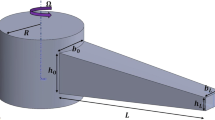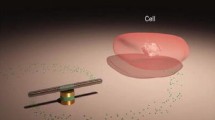Abstract
In this study, free lateral vibration behavior of a functionally graded nanobeam in an elastic matrix with rotationally restrained ends is studied based on the Eringens’ nonlocal theory of elasticity formulated in differential form. Euler–Bernoulli beam theory, Fourier sine series and Stokes’ transformation are used to investigate the vibrational behavior of nanobeams with restrained boundary conditions. Although vibration based dynamical analysis of nanostructures is a widely investigated topic, there are only few studies that exist in the literature pertaining to the analysis of nanobeams with rotationally restrained boundary conditions. To investigate and analyze the effect of deformable boundary conditions on the lateral vibration of nanobeams, the Fourier coefficients obtained by using Stokes’ transformation. Explicit formulas are derived for the elastic nonlocal boundary conditions at the ends. A useful coefficient matrix is derived by using these equations. Moreover, the effects of some parameters such as functional gradient index, nonlocal parameter, and rotational restraints on the natural frequencies are studied and some conclusions are drawn.









Similar content being viewed by others
References
Ajayan PM, Lijima S (1992) Smallest carbon nanotube. Nature 358:23
Akbas SD (2018) Forced vibration analysis of cracked functionally graded microbeams. Adv Nano Res 6(1):39–55
Antonelli GA, Maris HJ, Malhotra SG, Harper JM (2002) Picosecond ultrasonics study of the vibrational modes of a nanostructure. J Appl Phys 91(5):3261–3267
Arash B, Wang Q (2012) A review on the application of nonlocal elastic models in modeling of carbon nanotubes and graphenes. Comput Mater Sci 51(1):303–313
Arda M, Aydogdu M (2014) Torsional statics and dynamics of nanotubes embedded in an elastic medium. Compos Struct 114:80–91
Arroyo M, Belytschko T (2005) Continuum mechanics modeling and simulation of carbon nanotubes. Meccanica 40(4–6):455–469
Aydogdu M (2009) Axial vibration of the nanorods with the nonlocal continuum rod model. Phys E Low Dimens Syst Nanostruct 41(5):861–864
Bachtold A, Hadley P, Nakanishi T, Dekker C (2001) Logic circuits with carbon nanotube transistors. Science 294(5545):1317–1320
Barretta R, Marotti de Sciarra F (2013) A nonlocal model for carbon nanotubes under axial loads. Adv Mater Sci Eng. https://doi.org/10.1155/2013/360935
Barretta R, Brcic M, Canadija M, Luciano R, de Sciarra FM (2017) Application of gradient elasticity to armchair carbon nanotubes: size effects and constitutive parameters assessment. Eur J Mech A Solids 65:1–13
Brauns EB, Madaras ML, Coleman RS, Murphy CJ, Berg MA (2002) Complex local dynamics in DNA on the picosecond and nanosecond time scales. Phys Rev Lett 88(15):158101
Bunch JS, Van Der Zande AM, Verbridge SS, Frank IW, Tanenbaum DM, Parpia JM, Craighead HG, McEuen PL (2007) Electromechanical resonators from graphene sheets. Science 315(5811):490–493
Chien WT, Chen CS, Chen HH (2006) Resonant frequency analysis of fixed-free single-walled carbon nanotube-based mass sensor. Sens Actuators A Phys 126(1):117–121
Chiu HY, Hung P, Postma HWC, Bockrath M (2008) Atomic-scale mass sensing using carbon nanotube resonators. Nano Lett 8(12):4342–4346
Chong ACM, Lam DCC (1999) Strain gradient plasticity effect in indentation hardness of polymers. J Mater Res 14:4103–4110
Chowdhury R, Adhikari S, Mitchell J (2009) Vibrating carbon nanotube based bio-sensors. Phys E Low Dimens Syst Nanostruct 42(2):104–109
Dai H, Hafner JH, Rinzler AG, Colbert DT, Smalley RE (1996) Nanotubes as nanoprobes in scanning probe microscopy. Nature 384(6605):147
Demir C, Civalek O, Akgoz B (2010) Free vibration analysis of carbon nanotubes based on shear deformable beam theory by discrete singular convolution technique. Math Comput Appl 15(1):57–65
Ebrahimi F, Mahmoodi F (2018) Vibration analysis of carbon nanotubes with multiple cracks in thermal environment. Adv Nano Res 6(1):57–80
El-Borgi S, Rajendran P, Friswell MI, Trabelssi M, Reddy JN (2018) Torsional vibration of size-dependent viscoelastic rods using nonlocal strain and velocity gradient theory. Compos Struct 186:274–292
Eringen AC (1983) On differential equations of nonlocal elasticity and solutions of screw dislocation and surface waves. J Appl Phys 54(9):4703–4710
Eringen AC, Edelen DGB (1972) On nonlocal elasticity. Int J Eng Sci 10:233–248
Filiz S, Aydogdu M (2010) Axial vibration of carbon nanotube heterojunctions using nonlocal elasticity. Comput Mater Sci 49(3):619–627
Heireche H, Tounsi A, Benzair A, Mechab I (2008) Sound wave propagation in single-walled carbon nanotubes with initial axial stress. J Appl Phys 104(1):014301
Joshi AY, Harsha SP, Sharma SC (2010) Vibration signature analysis of single walled carbon nanotube based nanomechanical sensors. Phys E Low Dimens Syst Nanostruct 42(8):2115–2123
Kim P, Lieber CM (1999) Nanotube nanotweezers. Science 286(5447):2148–2150
Lau KT, Gu C, Hui D (2006) A critical review on nanotube and nanotube/nanoclay related polymer composite materials. Compos Part B Eng 37(6):425–436
Lim CW, Yang Y (2010) New predictions of size-dependent nanoscale based on nonlocal elasticity for wave propagation in carbon nanotubes. J Comput Theor Nanosci 7(6):988–995
Lu P, Lee HP, Lu C, Zhang PQ (2007) Application of nonlocal beam models for carbon nanotubes. Int J Solids Struct 44(16):5289–5300
Mehdipour I, Barari A (2012) Why the center-point of bridged carbon nanotube length is the most mass sensitive location for mass attachment? Comput Mater Sci 55:136–141
Murmu T, Adhikari S, Wang CY (2011) Torsional vibration of carbon nanotube–buckyball systems based on nonlocal elasticity theory. Phys E Low Dimens Syst Nanostruct 43(6):1276–1280
Peddieson J, Buchanan GR, McNitt RP (2003) Application of nonlocal continuum models to nanotechnology. Int J Eng Sci 41(3–5):305–312
Pradhan SC, Murmu T (2009) Differential quadrature method for vibration analysis of beam on Winkler foundation based on nonlocal elastic theory. J Inst Eng (India) Metall Mater Eng Div 89:3–12
Qian D, Wagner GJ, Liu WK, Yu MF, Ruoff RS (2002) Mechanics of carbon nanotubes. Appl Mech Rev 55(6):495–533
Reddy JN (2007) Nonlocal theories for bending, buckling and vibration of beams. Int J Eng Sci 45(2–8):288–307
Schedin F, Geim AK, Morozov SV, Hill EW, Blake P, Katsnelson MI, Novoselov KS (2007) Detection of individual gas molecules adsorbed on graphene. Nature materials 6(9):652
Sirtori C (2002) Applied physics: bridge for the terahertz gap. Nature 417(6885):132
Stankovich S, Dikin DA, Dommett GH, Kohlhaas KM, Zimney EJ, Stach EA, Piner ST, Nguyen RS, Ruoff RS (2006) Graphene-based composite materials. Nature 442(7100):282
Sudak LJ (2003) Column buckling of multiwalled carbon nanotubes using nonlocal continuum mechanics. J Appl Phys 94(11):7281–7287
Thostenson ET, Ren Z, Chou TW (2001) Advances in the science and technology of carbon nanotubes and their composites: a review. Compos Sci Technol 61(13):1899–1912
Wagner HD, Lourie O, Feldman Y, Tenne R (1998) Stress induced fragmentation of multiwall carbon nanotubes in a polymer matrix. Appl Phys Lett 72(2):188–190
Wan H, Delale F (2010) A structural mechanics approach for predicting the mechanical properties of carbon nanotubes. Meccanica 45(1):43–51
Yayli MO (2016) A compact analytical method for vibration analysis of single-walled carbon nanotubes with restrained boundary conditions. J Vib Control 22(10):2542–2555
Yayli MO (2018a) An efficient solution method for the longitudinal vibration of nanorods with arbitrary boundary conditions via a hardening nonlocal approach. J Vib Control 24(11):2230–2246
Yayli MÖ (2018b) Torsional vibrations of restrained nanotubes using modified couple stress theory. Microsyst Technol 24(8):3425–3435
Yayli MÖ (2018c) On the torsional vibrations of restrained nanotubes embedded in an elastic medium. J Braz Soc Mech Sci Eng 40(9):419
Yayli MÖ (2018d) Free vibration analysis of a single-walled carbon nanotube embedded in an elastic matrix under rotational restraints. Micro Nano Lett 13(2):202–206
Yayli MÖ, Cercevik AE (2015) 1725. Axial vibration analysis of cracked nanorods with arbitrary boundary conditions. J Vibroeng 17(6):2907–2921
Zhang YQ, Liu GR, Wang JS (2004) Small-scale effects on buckling of multiwalled carbon nanotubes under axial compression. Phys Rev B 70(20):205430
Author information
Authors and Affiliations
Corresponding author
Additional information
Publisher's Note
Springer Nature remains neutral with regard to jurisdictional claims in published maps and institutional affiliations
Rights and permissions
About this article
Cite this article
Yayli, M.Ö. Free vibration analysis of a rotationally restrained (FG) nanotube. Microsyst Technol 25, 3723–3734 (2019). https://doi.org/10.1007/s00542-019-04307-4
Received:
Accepted:
Published:
Issue Date:
DOI: https://doi.org/10.1007/s00542-019-04307-4




